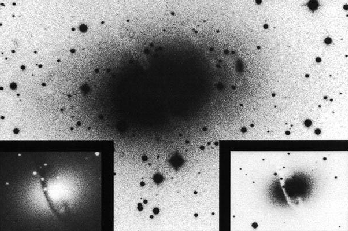
Positive and negative prints of the minor-axis dust lane elliptical galaxy NGC5266.

Below is a description of some of the work I have done and some of the projects I have participated in concerning early-type galaxies (ellipticals and lenticulars). Unfortunately, lack of time prevents me from putting on the web everything I am involved in, but my publications list (which is up-to-date) should alleviate this problem somewhat.
My interest in early-type galaxies centers around the issue of their formation and evolution, presumably mainly through merging events. Most of my involvement revolves around the SAURON (and follow-up) projects. As such, I am mostly interested in issues of structure, stellar/gas kinematics, and stellar populations.
| SAURON | Molecular Gas | ||||
| NGC2974 | M32 | NGC 4365 | |||
SAURON Project:
I am a member of the
SAURON team which, with the
SAURON spectrograph as its main asset, is carrying out a large
survey of the kinematics and stellar populations of early-type
galaxies. We are observing a representative sample of 24 elliptical
galaxies, 24 lenticulars, and 24 spiral bulges, all nearby and equally
divided between field and cluster objects, as well as a fair number of
particularly interesting objects. We produce maps of the stellar
kinematics, gaseous kinematics, and linestrength indices of the
galaxies covering at least an effective radius. The survey is aimed,
amongst other things, at determining the intrinsic shape of the
galaxies, their orbital structure, the mass-to-light ratio as a
function of radius, the age and metallicity of the stellar
populations, and the frequency of kinematically decoupled cores and
nuclear black holes, thus ultimately shedding light on the connection
between gas, stars, and the history of star formation in those
galaxies. More information on the SAURON project, its
goals, members, publications, etc can be found here.

In Paper I ( Bacon et al. 2001, MNRAS, 326, 23) and the Instrumentation section of these pages, the SAURON spectrograph is fully described, as well as the related XSAURON data reduction and analysis software.
In Paper II ( de Zeeuw et al. 2002, MNRAS, 329, 513), the construction of the representative sample was described and its properties illustrated. We also compared SAURON and long-slit spectroscopic data and showed that the SAURON measurements are comparable to, or better than, the highest-quality determinations. We presented comparisons for NGC3384 and NGC4365, where stellar velocities and velocity dispersions are determined to a precision of 6 km s^-1 and the h3 and h4 parameters of the line-of-sight velocity distribution (LOSVD) to better than 0.02. We illustrated the extraction of accurate emission-line intensities, velocities, and linewidths from the data cubes for the galaxy NGC5813. Comparisons with published linestrengths for NGC3384 and NGC5813 revealed uncertainties of less than 0.1 A on the measurements of the H_beta, Mg_b, and Fe5270 indices. The maps presented illustrate the rich stellar kinematics, gaseous kinematics, and linestrength distributions of early-type galaxies. Early results presented include the discovery of a thin edge-on disc in NGC3623, confirmation of the axisymmetric shape of the central regions of M32, illustration of the LINER nucleus and surrounding counter-rotating star-forming ring in NGC7742, and suggestion of a uniform stellar population in the kinematically-decoupled core galaxy NGC5813.
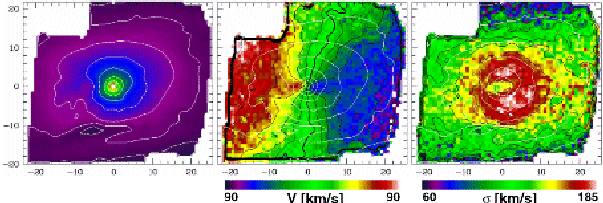
Paper III (Emsellem et al. 2004, MNRAS, 352, 721) of the series presents the stellar kinematics of the 48 elliptical and lenticular galaxies of the SAURON representative sample. The data were homogeneously processed through a dedicated reduction and analysis pipeline and all the data cubes were spatially binned to a constant minimum signal-to-noise ratio. We measured the stellar kinematics with an optimized (penalized pixel-fitting) routine which fits the spectra in pixel space using optimal templates and accounts for the presence of emission lines. We thus generated maps of the mean stellar velocity, the velocity dispersion, and the Gauss-Hermite moments h3 and h4 of the line-of-sight velocity distributions. The maps extend to approximately one effective radius. Many objects display kinematic twists, kinematically decoupled components, central stellar discs, and other peculiarities, the nature of which is discussed in latter papers of this series.
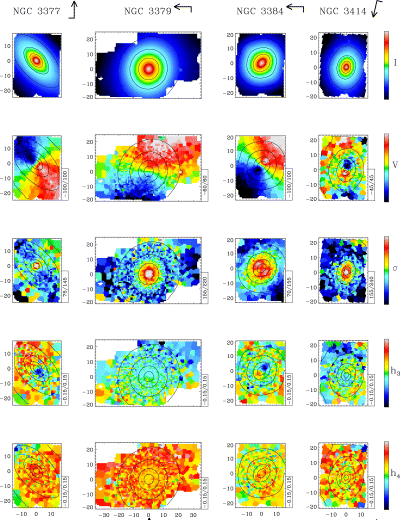
Paper IV ( Cappellari et al. 2006, MNRAS, 366, 1126) explores the well-known correlations between the dynamical mass-to-light ratio M/L and other global observables of elliptical (E) and lenticular (S0) galaxies. Two-integral Jeans and three-integral Schwarzschild dynamical models for a sample of 25 objects with SAURON data and kinematics consistent with axisymmetry were constructed. We found a tight correlation (M/L)=(3.79+/-0.13) x (sigma_e / 200 km/s)^(0.82+/-0.06) between the M/L measured from the dynamical models and the second moment of the line-of-sight velocity-distribution within Re. The observed scatter in M/L is 17% while the intrinsic scatter is negligible. The comparison of this and other correlations with the predictions of the Fundamental Plane (FP), and with simple virial estimates, shows that the "tilt" of the FP is almost exclusively due to M/L variations, while structural and orbital non-homology have a negligible effect. The virial mass is also found to be a reliable estimator of the mass in the central regions of galaxies, and it can be safely used where more complex models are not feasible. The best-fitting virial relation has the form (M/L)_vir=(4.8+/-0.1) x Re sigma_e^2 / (LG), in good agreement with simple theoretical predictions. We found no difference between the M/L of galaxies in clusters and in the field. The comparison of the dynamical M/L with (M/L)_pop inferred from the stellar populations indicates that dark matter in early-type galaxies contributes about 30% of the total mass inside Re, and it shows that the stellar initial mass function varies little among galaxies. Our results suggest a variation in M/L at constant (M/L)_pop linked to the galaxy dynamics. We speculated that fast rotating galaxies have lower dark matter fractions than the slow rotating and generally more massive ones, which would suggest a connection between the galaxy assembly history and the dark matter halo structure.
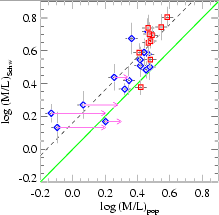
Paper V ( Sarzi et al. 2006, MNRAS, 366, 1151) presents the emission-line fluxes and kinematics of the 48 representative elliptical and lenticular galaxies of the SAURON survey. Hbeta, [O III]4959,5007 and [N I]5198,5200 emission lines were measured using a new procedure that simultaneously fits both the stellar spectrum and the emission lines. We can detect emission lines down to an equivalent width of 0.1 A, set by the current limitations in describing galaxy spectra with synthetic and real stellar templates rather than by the quality of our spectra. Emission is clearly detected in 75% of our sample galaxies, and comes in a variety of resolved spatial distributions and kinematic behaviours. A mild dependence on the Hubble type and galactic environment is observed, with higher detection rates in lenticular galaxies and field objects. More significant is the fact that only 55% of the galaxies in the Virgo cluster have clearly detected emission. The ionized-gas kinematics is rarely consistent with simple coplanar circular motions. However, the gas almost never displays completely irregular kinematics, generally showing coherent motions with smooth variations in angular momentum. In the majority of the cases, the gas kinematics is decoupled from the stellar kinematics, and in half of the objects this decoupling implies a recent acquisition of gaseous material. Over the entire sample, however, the distribution of the mean misalignment values between stellar and gaseous angular momenta is inconsistent with a purely external origin. The distribution of kinematic misalignment values is found to be strongly dependent on the apparent flattening and the level of rotational support of galaxies, with flatter, fast rotating objects hosting preferentially corotating gaseous and stellar systems. In a third of the cases, the distribution and kinematics of the gas underscore the presence of non-axisymmetric perturbations of the gravitational potential. Consistent with previous studies, the presence of dust features is always accompanied by gas emission while the converse is not always true. A considerable range of values for the [O III]/Hbeta ratio is found both across the sample and within single galaxies, suggesting either that a variety of mechanisms is responsible for the gas excitation in E and S0 galaxies or that the metallicity of the interstellar material is quite heterogeneous.
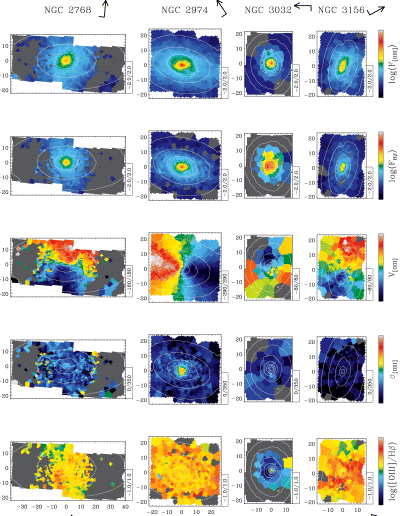
Paper VI ( Kuntschner et al. 2006, MNRAS, 369, 497) presents absorption line strength maps of the 48 representative elliptical and lenticular galaxies of the SAURON survey. We measured four key age, metallicity and abundance ratio sensitive indices from the Lick/IDS system over a two-dimensional field extending up to approximately one effective radius. We modified the classical Fe5270 index to define a new index, Fe5270S, which maximizes the useable spatial coverage of SAURON. Maps of Hbeta, Fe5015, Mgb and Fe5270S are presented for each galaxy. We used the maps to compute average line strengths integrated over circular apertures of one-eighth effective radius, and compared the resulting relations of index versus velocity dispersion with previous long-slit work. The metal line strength maps show generally negative gradients with increasing radius, roughly consistent with the morphology of the light profiles. Remarkable deviations from this general trend however exist, particularly the Mgb isoindex contours appear to be flatter than the isophotes of the surface brightness for about 40% of the galaxies without significant dust features. Generally, these galaxies exhibit significant rotation. We infer from this that the fast-rotating component features a higher metallicity and/or an increased Mg/Fe ratio as compared to the galaxy as a whole. The Hbeta maps are typically flat or show a mild positive outwards radial gradient, while a few galaxies show strong central peaks and/or elevated overall Hbeta strength likely connected to recent star formation activity. For the most prominent post-starburst galaxies, even the metal line strength maps show a reversed gradient.
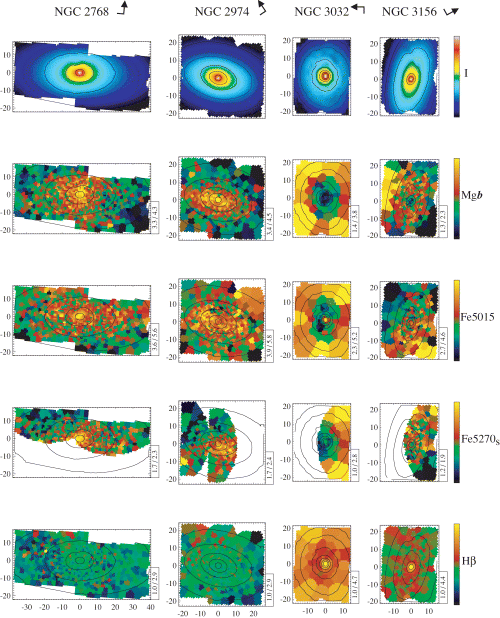
In Paper VII ( Falcon-Barroso et al. 2006, MNRAS, 369, 529) and the Disk Galaxies section of these pages, the SAURON work on the bulges of Sa galaxies is fully described.
Paper VIII ( Mcdermid et al. 2006, MNRAS, 373, 906) presents high spatial resolution integral-field spectroscopy of 28 elliptical and lenticular galaxies from the SAURON survey, obtained with the OASIS spectrograph during its operation at the Canada-France-Hawaii Telescope. The seeing-limited observations explore the central 8×10 arcsec (typically 1 kpc diameter) regions of the targets with a spatial sampling four times higher than SAURON, resulting in a factor of 2 improvement in spatial resolution. We measured the stellar and ionised-gas kinematics, stellar absorption line strengths and emission line strengths for the sample. We then characterized the stellar velocity maps using kinemetry, and derived maps of the luminosity-weighted stellar age, metallicity and abundance ratio using (single) stellar population models. Kinematically decoupled cores (KDCs) were discovered in NGC3032 and NGC4382. Most importantly, by comparing the intrinsic size and luminosity-weighted stellar age of all KDCs in the SAURON sample, we found two types: kiloparsec-scale KDCs, which are older than 8 Gyr and are found in galaxies with little net rotation; and compact KDCs, which have intrinsic diameters of less than a few hundred parsecs, are typically younger than 5 Gyr, are found exclusively in fast-rotating galaxies, and are nearly exactly counter-rotating. Of the seven galaxies with luminosity-weighted ages less than 5 Gyr, five show such compact KDCs, strongly suggesting a link between counter-rotation and recent star formation. This effect may however be due to an observational bias, since young KDCs are easier to detect than their older and/or corotating counterparts.
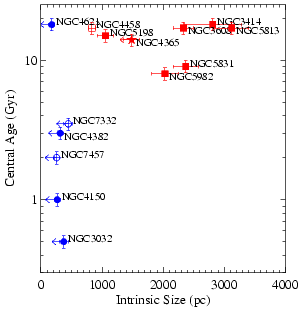
Paper IX ( Emsellem et al. 2007, MNRAS, 379, 401) revealed that early-type galaxies appear in two broad flavours, depending on whether they exhibit clear large-scale rotation or not. We defined a new parameter, lambda_R = < R|V| > / < R sqrt(V^2 + sigma^2) >, which involves luminosity-weighted averages over the full two-dimensional kinematic fields as a proxy to the observed projected stellar angular momentum per unit mass. We use it as a basis for a new kinematic classification: early-type galaxies are separated into slow and fast rotators, depending on whether they have lambda_R values within their effective radius below or above 0.1. Slow and fast rotators were shown to be physically distinct classes of galaxies. Fast rotators tend to be relatively low-luminosity galaxies with M_B > 20.5. Slow rotators tend to be brighter and more massive, but are still spread over a wide range of absolute magnitude. Three slow rotators of our sample, among the most massive ones, are also consistent with zero rotation. Remarkably, all other slow rotators contain a large kpc-scale kinematically decoupled core (KDC). All fast rotators show well-aligned photometric and kinemetric axes, and small velocity twists, in contrast with most slow rotators which exhibit significant misalignments and velocity twists. We suggested that gas is a key ingredient in the formation and evolution of fast rotators, and that the slowest rotators are the extreme evolutionary end point reached in deep gravitational potential wells where dissipationless mergers had a major role, and for which most of the baryonic angular momentum was expelled outwards. Nevertheless, detailed numerical simulations in a cosmological context are required to understand how to form large-scale KDCs within slow rotators, and more generally to explain the distribution of lambda_R values amongst early-type galaxies and the distinction between fast and slow rotators.
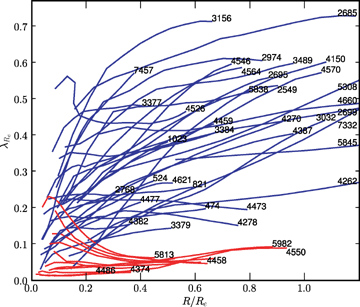
Paper X ( Cappellari et al. 2007, MNRAS, 379, 418) probed the orbital distribution of the SAURON E/S0 galaxies within about one effective (half-light) radius. We constructed the anisotropy diagram, which relates the ratio of the ordered and random motion in a galaxy (V/sigma) to its observed ellipticity (e), and for a subsample of 24 galaxies consistent with axisymmetry we used three-integral axisymmetric Schwarzschild dynamical models to recover the detailed orbital distribution (see Paper IV), finding good agreement for the anisotropies. The slow and fast rotators (see Paper IX) have different distributions in the (V/sigma, e) diagram. Slow rotators are more common among the most massive systems and are generally classified as E from photometry alone. Those in our sample tend to be fairly round (e<0.3), but can have significant kinematical misalignments indicating that as a class they are moderately triaxial, and span a range of anisotropies (delta<0.3). Fast rotators are generally fainter and are classified as either E or S0. They can appear quite flattened (e<0.7), do not show significant kinematical misalignments indicating they are nearly axisymmetric, and span an even larger range of anisotropies (delta<0.5). The dynamical models indicate that the anisotropy inferred from the (V/sigma, e) diagram is due to a flattening of the velocity ellipsoid in the meridional plane (sigma_r > sigma_z), which we quantify with the beta anisotropy parameter. We find a trend of increasing beta for intrinsically flatter galaxies. A number of the fast rotators show evidence for containing a flattened, kinematically distinct component, which in some cases counter-rotates relative to the main galaxy body. These components are generally more metal rich than the galaxy body. All these results support the idea that fast rotators are nearly oblate and contain disc-like components. The role of gas must have been important for their formation. The slow rotators are weakly triaxial, but current collisionless merger models seem unable to explain their detailed observed properties.
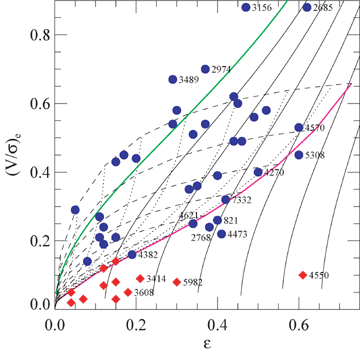
In my first paper together with Lisa Young (New Mexico Tech) and Francoise Combes (Observatoire de Paris), I carried out
a survey of CO emission in 43 of the 48 E/S0 galaxies observed with
the SAURON integral-field spectrograph. The CO
detection rate is 28% (12/43). This is lower than previous studies of
early-types but can probably be attributed to different sample
selection criteria. As expected, earlier type, more luminous and
massive galaxies have a relatively lower molecular gas content. We
also find that CO-rich galaxies tend to have higher Hbeta but lower Fe
and Mg absorption indices than CO-poor galaxies. Those trends appear
primarily driven by the age of the stars, a hypothesis supported by
the fact that the galaxies with the strongest evidence of star
formation are also the most CO-rich. In fact, the early-type galaxies
from the current sample appear to extend the well-known correlations
between far-infrared (FIR) luminosity, dust mass and molecular mass of
other galaxy types. The star formation interpretation is also
consistent with the SAURON galaxies' radio continuum and FIR flux
ratios, and their inferred star formation efficiencies are similar to
those in spiral galaxies. It thus appears that we have identified the
material fueling (residual) star formation in early-type galaxies, and
have demonstrated that it is actively being transformed. Nevertheless,
the lack of strong correlations between the CO content and most
stellar parameters is consistent with the idea that, in a significant
number of sample galaxies, the molecular gas has been accreted from
the outside and has properties rather independent from the old,
pre-existing stellar component.
A paper describing this work has appeared in
Combes, F., Young, L. M., & Bureau, M. 2007, MNRAS, 377,
1795. You can also download it here in
preprint format.
A paper describing this work has appeared in
Jeong, H., Bureau, M., Yi, S. K., Krajnovic, D., & Davies,
R. L. 2007, MNRAS, 376, 1021. You can also download it here in preprint format.
Molecular Gas:
Together with a growing list of collaborators, I have become
interested in the molecular gas content of early-type galaxies,
forming the gas reservoir out of which new stars form. As early-type
galaxies are generally thought to be composed of old stars and to
have no star formation (i.e. to be red and dead!), this may not seem
like a promising research topic. But as a growing body of evidence
shows, early-type galaxies do have ongoing residual star formation and
complex interstellar media, and the molecular gas (as traced by CO)
plays a crucial role. Read on...
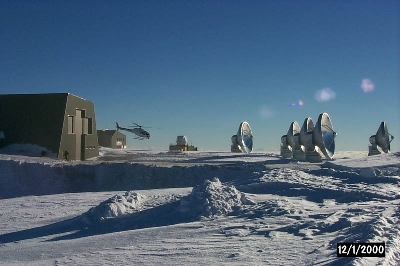
The IRAM Plateau de Bure mm interferometer, where the brunt of our
observing takes place.
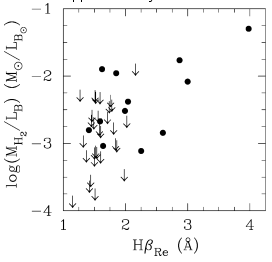
Plot of the normalised molecular gas content of the SAURON
early-type galaxies as a function of the Hbeta absorption
linestrength. Younger stellar populations (as traced by higher Hbeta
values) have more molecular gas, as expected if the latter provides
the fuel for star formation.
NGC2974:
Together with
Hyunjin Jeong and Sukyoung
Yi (both Yonsei
University), I carried out a near (NUV) and far (FUV) ultraviolet
imaging study of the early-type galaxy NGC2974 using the Galaxy Evolution Explorer
(GALEX) satellite (along with complementary ground-based optical
imaging). In the UV, the galaxy reveals a central spheroid-like
component and a newly discovered complete outer ring of radius 6.2
kpc, with suggestions of another partial ring at an even larger
radius. Blue FUV-NUV and UV-optical colours are observed in the centre
of the galaxy and from the outer ring outwards, suggesting young
stellar populations (<1 Gyr) and recent star formation in both
locations. This is supported by a simple stellar population model
which assumes two bursts of star formation, allowing us to constrain
the age, mass fraction and surface mass density of the young component
pixel by pixel. Overall, the mass fraction of the young component
appears to be just under 1%. The additional presence of a nuclear and
an inner ring, as traced by [OIII] emission, suggests ring formation
through resonances. All three rings are consistent with a single
pattern speed of 78 +/- 6 km/s/kpc, typical of S0 galaxies and only
marginally slower than expected for a fast bar. This thus suggests
that star formation and morphological evolution in NGC 2974 at the
present epoch are primarily driven by a rotating asymmetry (probably a
large-scale bar), despite the standard classification of NGC 2974 as
an E4 elliptical.
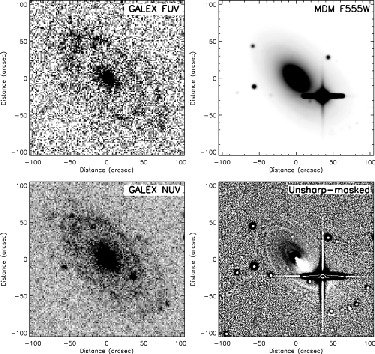
GALEX UV and MDM optical
images of the central 100''×100'' of NGC2974. Top-left: FUV
image. Bottom-left: NUV image. Top-right: F555W image. Bottom-right:
Unsharp-masked F555W image. Note the star forming outer rings, easily
visible in the UV but essentially invisible in the optical.
M32:
Together with Ellen Verolme (
Leiden University) and the SAURON team SAURON
team
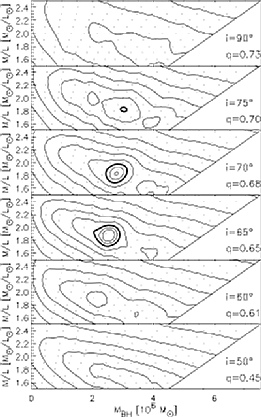
A paper describing this work has appeared in Verolme, E., et al. 2002, MNRAS, 335, 517. You can also download it here in preprint format.
NGC4365:
With the SAURON
team, I reported the first wide-field mapping of the kinematics
and stellar populations in the E3 galaxy NGC4365. Obtained with the SAURON spectrograph, the
kinematic maps extend previous long-slit work. They show two
independent kinematic subsystems: the central 300x700 pc rotates about
the projected minor axis and the main body of the galaxy (3x4 kpc)
rotates quasi-perpendicular to this. The linestrength maps showed a
decrease in the metallicity of the stellar populations from a central
value greater than solar to half solar at a radius of 2 kpc. The
decoupled core and main body of the galaxy have the same
luminosity-weighted age, about 14 Gyr, and the same elevated
magnesium-to-iron ratio. The two kinematically distinct components
have thus shared a common star formation history. We argued that the
galaxy underwent a sequence of mergers associated with dissipative
star formation that ended about 12 Gyr ago. The misalignment between
the photometric and kinematic axes of the main body is unambiguous
evidence of triaxiality and the similarity of the stellar populations
in the two components suggests that the observed kinematic structure
has not changed substantially in a Hubble time.
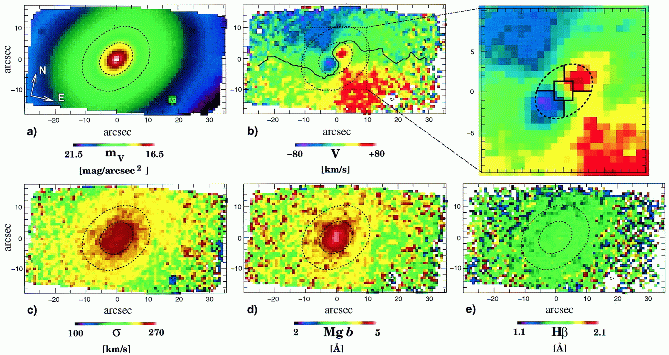
A paper describing this work has appeared in Davies et al. (2001). You can also download it here in preprint format.
To go back to my Home Page, click here:
![]()
This page was last modified on August 1 2007